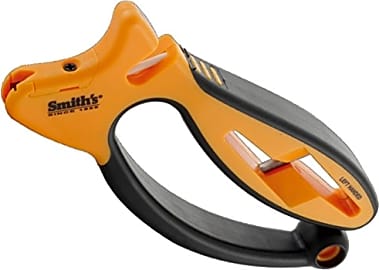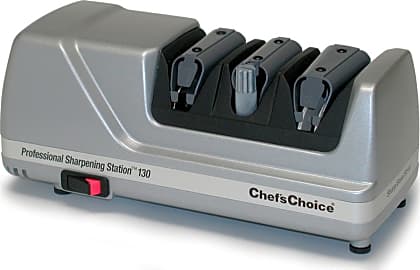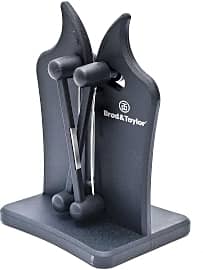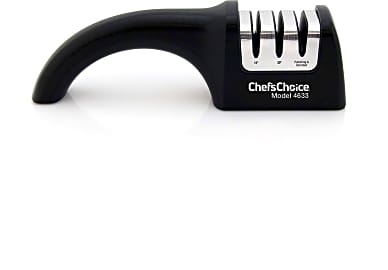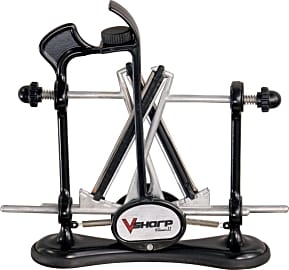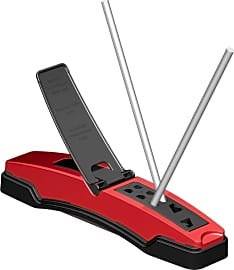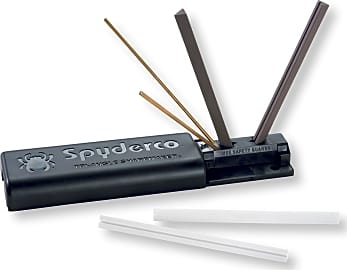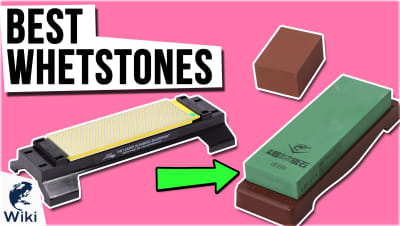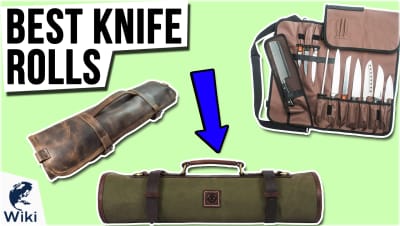The 10 Best Knife Sharpeners

This wiki has been updated 45 times since it was first published in February of 2015. The sharper a knife, the easier it is to use, and after a while, a honing rod won't do the trick any more. Our selection of knife sharpeners will give you the "edge" for chopping with precision again in no time, whether you're a home cook or a restaurant chef. We've also found some that are great for keeping in your tool box or camping equipment for attending to utility knives. When users buy our independently chosen editorial picks, we may earn commissions to help fund the Wiki.
Editor's Notes
August 14, 2020:
Some people will tell you that a sharp knife is safer than a dull knife, and that's not exactly true - but it will be easier and more consistent to use, and the better care you take of your blades, the easier they are to touch up when they really need it. This time around, we added the Lansky Deluxe in the top spot because of its balance of simplicity and diverse function. It's able to work at 4 angles and provide 5 steps from fine to coarse, and it's been around for years - even old-school knife collectors will frequently know about it.
The Chef's Choice 4633 is a good choice for chefs who want to outfit their kitchen but don't want to spend a fortune. If you have a ton of blades that gets heavy use, such as those in high-volume commercial institutions, the Chef's Choice 130 and Chef's Choice 1520 are good, but expensive choices. Alternatively, the Mac Ceramic Rod is the one you need for taking care of high-end blades in a professional kitchen where both skill and speed are important. However, if you have a little more time to spend and are concerned about keeping your expensive blades in tip-top shape and looking their best, consider springing for a good whetstone instead.
The most practical-minded users, and especially those who camp, hike, or hunt, will appreciate the ease of use, portability, and reliability of the Smith's Jiffy-Pro, which is safe and effective, and should last for years of use.
March 28, 2019:
First of all, if you're working on a high-dollar blade that you've invested time and money into, head over to our list of whetstones, and consider learning how to hand-sharpen; your high-end cutlery will really appreciate it. But if you're restoring several plastic-handled, industry standard blades, or trying to bring an old and extensive set back to life, you'll likely benefit from one of the devices. For the most part, they're constructed somewhat more complicated than a simple stone, but they're considerably easier to use, with a much smaller learning curve. Do keep in mind, though, that because they're so easy to use, they're also easy to over-use. Over-sharpening a knife is not good for the edge, as it can significantly reduce the length of time it holds up between honing and sharpening sessions. And every knife sharpener works best alongside a good honer (or two); using a smooth, honing rod, preferably of stainless steel, is almost always necessary, even after using one of these sharpeners. If you don't follow up a sharpening with a good honing (and maybe even a stropping), you'll never get to experience the blade as shard as it could really be.
With all of that breathless cautioning out of the way, there are a few distinctly different styles of devices to choose from. The simplest by far is the rod, and we've found that Mac's Black Ceramic Rod is among the best of those. Its rubber tip is made to be planted firmly on the counter to prevent dangerous slips during use. Its ridges are great for bringing worn edges back into true, while its smooth side is ideal for lightly sharpening even the fanciest Japanese blades. While it does have a minor learning curve, it's still great for less experienced users, because it's not as easy to over-sharpen using a rod as it is with a coarse carbide sharpening device. And because it's made of ceramic, rather than the steel of a standard rod, it does incrementally remove material, whereas a steel rod would simply re-align the edge.
Smith's Jiffy-Pro and the V-Sharp Classic are both good options for utility knives, especially if they're not kitchen knives. The Jiffy-Pro is remarkably cheap, easy, and safe to use, while the V-Sharp has a large entry area and as such is ideal for thicker hunting knives. Brod and Taylor makes a similar dual-sided design that's meant more for culinary use, as it's a little slimmer than others of similar build. The Lanksy and SpyderCo are both pretty versatile, though they do hae a pretty steep learning curve, as they require essentially free-handed use, which takes a little bit more control than something dual-sided or handheld. The PreciSharp and PriorityChef are both really easy to use, as they're simple, unpowered, pull-through models.
Finally, Chef's Choice is lauded for its effectiveness, and their machines really are fantastic, but they are by no means foolproof. They require a steady hand, and above all, restraint: a powered knife sharpener works well the first time, and additional uses beyond what's recommended can seriously harm the performance and life of a blade. But as long as you work carefully and follow directions, they will serve you perfectly. And no matter which you're using, always practice knife safety, and pay careful attention to all the blades you're working with. Trust us, it's neither easy nor fun to cook, hunt, or camp while you're bleeding.
A Dull Beginning
A grindstone or whetstone is usually employed at this stage of the process.
A simple fact of life is that sharp knives will dull. You cannot avoid this, nor can you ever purchase a non-dulling knife. Now that we have come to terms with this harsh reality, we can correct course to sharpen our blades to achieve optimal performance. If you are someone who uses blades frequently; hunter, chef, serial killer, you need a way of sharpening your tools.
Knives need to be sharpened for a myriad of reasons: corrosion by acid, getting bent, and repetition of cuts all weaken and dull the knife, creating blade damage. Luckily for us, there are methods to refine the edge resulting in fewer new knives purchased.
Knife sharpening is a complex process and it is achieved in several stages. First, the blade is sharpened. The semantics of the word sharpening can be tricky. Here it is defined as grinding the blade against a hard surface, or a soft surface with hard particles, such as sandpaper. The hard surface will grind away the old dull surface of the blade, exposing the new metal underneath. A grindstone or whetstone is usually employed at this stage of the process. The rougher grit will be used first, then a refined sharpening can occur using a finer grit.
The next step is straightening, which is also known as honing the blade. The aim is to realign the newly exposed metal and this is achieved with a honing steel. This does not remove much, if any, metal from the blade. The hone will smooth out the nicks and rough patches caused by the destructive sharpening phase. This is known as burnishing the blade. The hone will look like a rod made of steel, though ceramic models are effective as well.
The final stage is polishing or stropping, which gives the blade a mirror finish. This is accomplished by using a razor strop, which is made of soft materials like leather or canvas. The existing metal is tempered enough to be reformed at this stage, making it easier to create a smooth edge.
Grinding, Steeling, And Stropping
The three stages of sharpening a blade can be named after the tools they use to achieve the desired effect: grinding, steeling, and stropping.
A whetstone is the primarily tool used for sharpening the blade. Most are synthetic and include particles in the stone to determine grit size. A larger grit will make for a rough grind, while a finer grit makes it smoother. Most stones will have two sides to facilitate a rough and a fine grind. An oil stone and a grindstone are similar variations of the whetstone. Diamond, of course, is a girl's best friend and a knife owner's dream. Considering it is the hardest known substance to man, it can sharpen anything and it's used for knives as well.
The three stages of sharpening a blade can be named after the tools they use to achieve the desired effect: grinding, steeling, and stropping.
Another option besides using whetstones is the scary sharp method. And yes, this is the actual name for it. The method employs using sandpaper to the same effect as a whetstone and it's ideal for woodworking tools.
In the next stage you must steel your blade. The honing steel rod is the most popular option, though, as mentioned previously, ceramic and even diamond rods give an excellent performance. The operator must adapt to a tough learning curve; blade precision is important at this stage and it requires you to hold the blade at consistent angles.
Lastly, the stropping stage. Remember seeing old barber shops on television? Remember that leather paddle they used to buff the straight razor? That is stropping. The strop can be leather or canvas and it's the final step in polishing the blade, making an even surface. Depending on the use of the knife, this step may be omitted. A chef will not require the blade precision chopping vegetables that a barber requires shaving with a straight razor on a gentleman's face. The chef may simple steel the blade and keep working.
Knives can last a long time, provided they are properly maintained. Cleaning, polishing, and oiling your knife all contribute to the longevity of the blade. Sharpen your knives frequently. I'm sure you have heard the saying, a dull knife is more dangerous than a sharp one. If you are uncertain as to how to test if you blade is dull, there are a number of tests you can perform.
A History With The Knife
Prehistorically, humans began to sharpen knives as soon as knives were used as tools. Evidence of stone knives sharpened were found to be in use over 75,000 years ago. Once humans began to use metals, the knives improved, along with their sharpness.
Western style knife sharpening can trace it's roots back to the mountains of Trento, Italy.
Western style knife sharpening can trace it's roots back to the mountains of Trento, Italy. The moletas were a staple in every Italian city. Characterized by their oversized hat and sharpening station, these men sharpened all the knives of the residents in the city. They delivered the knives to the people on horse drawn carriages.
At the turn of the century, these immigrants moved to New York and brought their knife sharpening skills with them. Grinding stones replaced the cumbersome pedal operated foot wheel, and business grew. The moletas were absorbed in American culture, and brick and mortar knife sharpening shops emerged.
Today, you can certainly bring your knives to be sharpened, but there is something special about doing it on your own. It does have a steep learning curve, but I can assure you, this skill will last you a lifetime.


